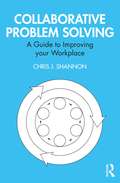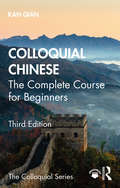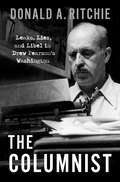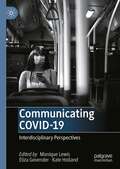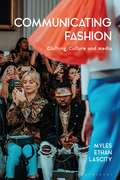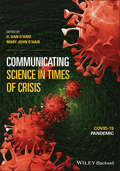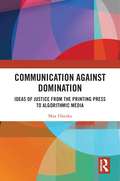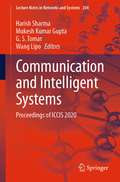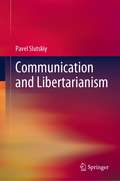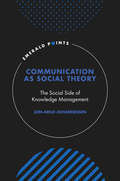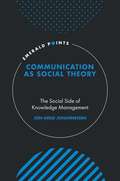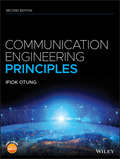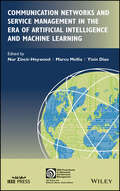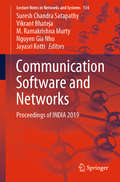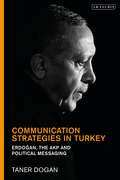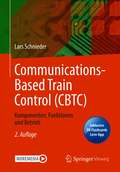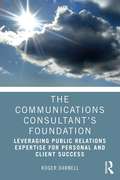- Table View
- List View
Collaborative Problem Solving: A Guide to Improving your Workplace
by Chris J. ShannonDrawing on knowledge from process improvement, organisation theory, human resource management, change management, occupational health and safety, and other fields, the book is a practical, easy-to-read guide to problem solving. Illustrated with a series of short case studies, this book provides an integrated approach to problem solving in the workplace. Collaborative Problem Solving walks through the steps in the problem solving process, introducing dozens of tools, techniques, and concepts to use throughout. Chris J. Shannon describes the behaviours to practice which are most conducive to creating a positive problem solving culture based on curiosity, collaboration, and evidence-based thinking. This book explains why successful problem solving is a collaborative process and provides tools and techniques for responding to other people’s behaviour when designing and implementing solutions. Offering practical advice on problem solving in an easy-to-understand way, this book is aimed at people working in office environments, service industries, and knowledge organisations, enabling them to feel confident in applying the knowledge from the book in their own workplace.
Collaborative Problem Solving: A Guide to Improving your Workplace
by Chris J. ShannonDrawing on knowledge from process improvement, organisation theory, human resource management, change management, occupational health and safety, and other fields, the book is a practical, easy-to-read guide to problem solving. Illustrated with a series of short case studies, this book provides an integrated approach to problem solving in the workplace. Collaborative Problem Solving walks through the steps in the problem solving process, introducing dozens of tools, techniques, and concepts to use throughout. Chris J. Shannon describes the behaviours to practice which are most conducive to creating a positive problem solving culture based on curiosity, collaboration, and evidence-based thinking. This book explains why successful problem solving is a collaborative process and provides tools and techniques for responding to other people’s behaviour when designing and implementing solutions. Offering practical advice on problem solving in an easy-to-understand way, this book is aimed at people working in office environments, service industries, and knowledge organisations, enabling them to feel confident in applying the knowledge from the book in their own workplace.
Collaborative Spaces at Work: Innovation, Creativity and Relations (Routledge Advances in Management and Business Studies)
by Fabrizio Montanari Elisa Mattarelli Anna Chiara ScapolanCollaborative spaces are more than physical locations of work and production. They present strong identities centered on collaboration, exchange, sense of community, and co-creation, which are expected to create a physical and social atmosphere that facilitates positive social interaction, knowledge sharing, and information exchange. This book explores the complex experiences and social dynamics that emerge within and between collaborative spaces and how they impact, sometimes unexpectedly, on creativity and innovation. Collaborative Spaces at Work is timely and relevant: it will address the gap in critical understandings of the role and outcomes of collaborative spaces. Advancing the debate beyond regional development rhetoric, the book will investigate, through various empirical studies, if and how collaborative spaces do actually support innovation and the generation of new ideas, products, and processes. The book is intended as a primary reference in creativity and innovation, workspaces, knowledge and creative workers, and urban studies. Given its short chapters and strong empirical orientation, it will also appeal to policy makers interested in urban regeneration, sustaining innovation, and social and economic development, and to managers of both collaborative spaces and companies who want to foster creativity within larger organizations. It can also serve as a textbook in master’s degrees and PhD courses on innovation and creativity, public management, urban studies, management of work, and labor relations.
Collaborative Spaces at Work: Innovation, Creativity and Relations (Routledge Advances in Management and Business Studies)
by Fabrizio Montanari Elisa Mattarelli Anna Chiara ScapolanCollaborative spaces are more than physical locations of work and production. They present strong identities centered on collaboration, exchange, sense of community, and co-creation, which are expected to create a physical and social atmosphere that facilitates positive social interaction, knowledge sharing, and information exchange. This book explores the complex experiences and social dynamics that emerge within and between collaborative spaces and how they impact, sometimes unexpectedly, on creativity and innovation. Collaborative Spaces at Work is timely and relevant: it will address the gap in critical understandings of the role and outcomes of collaborative spaces. Advancing the debate beyond regional development rhetoric, the book will investigate, through various empirical studies, if and how collaborative spaces do actually support innovation and the generation of new ideas, products, and processes. The book is intended as a primary reference in creativity and innovation, workspaces, knowledge and creative workers, and urban studies. Given its short chapters and strong empirical orientation, it will also appeal to policy makers interested in urban regeneration, sustaining innovation, and social and economic development, and to managers of both collaborative spaces and companies who want to foster creativity within larger organizations. It can also serve as a textbook in master’s degrees and PhD courses on innovation and creativity, public management, urban studies, management of work, and labor relations.
Colloquial Chinese: The Complete Course for Beginners
by Qian KanColloquial Chinese: The Complete Course for Beginners has been carefully developed by a leading academic in Chinese language teaching and course design. Based on feedback from learners and teachers who used its previous version, this new edition has been updated to reflect the language and cultural changes in China, such as online shopping and WeChat payment, and to provide a more integrated and step-by-step approach to making the learning of modern Mandarin Chinese more effective and enjoyable. Combining a clear, practical and accessible style with a methodical and thorough treatment of the language, it equips learners with the essential knowledge and skills needed to communicate confidently and effectively in Chinese in a broad range of situations. No prior knowledge of the language is required. Colloquial Chinese is exceptional; each unit presents a wealth of grammatical points that are reinforced with a wide range of exercises for regular practice. A full answer key, a grammar summary, bilingual glossaries and English translations of dialogues can be found at the back, as well as transcripts of listening practice exercises. Key features include: A clear, user-friendly format designed to help learners progressively build up their speaking, listening, reading and writing skills Jargon-free, succinct and clearly structured explanations of grammar Step by step introduction of Chinese characters An extensive range of focused and dynamic supportive exercises A combination of listening, reading and speaking activities with the support of transcripts at the back of the book Realistic and entertaining dialogues covering a broad variety of narrative situations Helpful cultural points explaining the customs and features of life in China An overview of the Chinese language: its sounds, structure and Chinese characters Balanced, comprehensive and rewarding, Colloquial Chinese is an indispensable resource both for independent learners and students taking courses in Chinese as well as teachers of Chinese. Audio material to accompany the course is available to download free in MP3 format from www.routledge.com/cw/colloquials. Recorded by native speakers, the audio material features the dialogues, new words and listening practice exercises from the book and will help develop your listening and speaking skills.
Colloquial Chinese: The Complete Course for Beginners
by Qian KanColloquial Chinese: The Complete Course for Beginners has been carefully developed by a leading academic in Chinese language teaching and course design. Based on feedback from learners and teachers who used its previous version, this new edition has been updated to reflect the language and cultural changes in China, such as online shopping and WeChat payment, and to provide a more integrated and step-by-step approach to making the learning of modern Mandarin Chinese more effective and enjoyable. Combining a clear, practical and accessible style with a methodical and thorough treatment of the language, it equips learners with the essential knowledge and skills needed to communicate confidently and effectively in Chinese in a broad range of situations. No prior knowledge of the language is required. Colloquial Chinese is exceptional; each unit presents a wealth of grammatical points that are reinforced with a wide range of exercises for regular practice. A full answer key, a grammar summary, bilingual glossaries and English translations of dialogues can be found at the back, as well as transcripts of listening practice exercises. Key features include: A clear, user-friendly format designed to help learners progressively build up their speaking, listening, reading and writing skills Jargon-free, succinct and clearly structured explanations of grammar Step by step introduction of Chinese characters An extensive range of focused and dynamic supportive exercises A combination of listening, reading and speaking activities with the support of transcripts at the back of the book Realistic and entertaining dialogues covering a broad variety of narrative situations Helpful cultural points explaining the customs and features of life in China An overview of the Chinese language: its sounds, structure and Chinese characters Balanced, comprehensive and rewarding, Colloquial Chinese is an indispensable resource both for independent learners and students taking courses in Chinese as well as teachers of Chinese. Audio material to accompany the course is available to download free in MP3 format from www.routledge.com/cw/colloquials. Recorded by native speakers, the audio material features the dialogues, new words and listening practice exercises from the book and will help develop your listening and speaking skills.
The Columnist: Leaks, Lies, and Libel in Drew Pearson's Washington
by Donald A. RitchieLong before Wikileaks and social media, the journalist Drew Pearson exposed to public view information that public officials tried to keep hidden. A self-professed "keyhole peeper", Pearson devoted himself to revealing what politicians were doing behind closed doors. From 1932 to 1969, his daily "Washington Merry-Go-Round" column and weekly radio and TV commentary broke secrets, revealed classified information, and passed along rumors based on sources high and low in the federal government, while intelligence agents searched fruitlessly for his sources. For forty years, this syndicated columnist and radio and television commentator called public officials to account and forced them to confront the facts. Pearson's daily column, published in more than 600 newspapers, and his weekly radio and television commentaries led to the censure of two US senators, sent four members of the House to prison, and undermined numerous political careers. Every president from Franklin Roosevelt to Richard Nixon--and a quorum of Congress--called him a liar. Pearson was sued for libel more than any other journalist, in the end winning all but one of the cases. Breaking secrets was the heartbeat of Pearson's column. His ability to reveal classified information, even during wartime, motivated foreign and domestic intelligence agents to pursue him. He played cat and mouse with the investigators who shadowed him, tapped his phone, read his mail, and planted agents among his friends. Yet they rarely learned his sources. The FBI found it so fruitless to track down leaks to the columnist that it advised agencies to simply do a better job of keeping their files secret. Drawing on Pearson's extensive correspondence, diaries, and oral histories, The Columnist reveals the mystery behind Pearson's leaks and the accuracy of his most controversial revelations.
Communicating COVID-19: Interdisciplinary Perspectives
by Kate Holland Monique Lewis Eliza GovenderThis book explores communication during the first year of the COVID-19 pandemic. Featuring the work of leading communication scholars from around the world, it offers insights and analyses into how individuals, organisations, communities, and nations have grappled with understanding and responding to the pandemic that has rocked the world. The book examines the role of journalists and news media in constructing meanings about the pandemic, with chapters focusing on public interest journalism, health workers and imagined audiences in COVID-19 news. It considers public health responses in different countries, with chapters examining community-driven approaches, communication strategies of governments and political leaders, public health advocacy, and pandemic inequalities. The role of digital media and technology is also unravelled, including social media sharing of misinformation and memetic humour, crowdsourcing initiatives, the use of data in modelling, tracking and tracing, and strategies for managing uncertainties created in a pandemic.
Communicating Fashion: Clothing, Culture, and Media
by Myles Ethan LascityHow did you decide what to wear today? Did you base your selection on comfort or style? Did you want to blend in or stand out - or was it just the cleanest outfit available? We each make these decisions every day, reflecting how we view ourselves and impacting how others see us. Our choices matter - not just to us personally, but also to the magazine editors, brand ambassadors and trend forecasters who make a living by selling to us. Communicating Fashion introduces key concepts from the intersecting worlds of fashion and communication studies to connect how we all use clothing to express ourselves and how media systems support that process. In doing so, Myles Ethan Lascity explores social, cultural and ethical issues through the work of fashion journalism, brand promotions and the growing role of online influencers as well as the impact of film, television and art on self-image and expression.Key topics:- Advertising, Branding and Fashion Retail- Clothing, Art and Cultural Significance- Clothing as Group and Cultural Norms- Clothing, Identity and Interpersonal Communication- Fashion News and Tastemaking- Fashion, Social Media and Influencers- Meaning within the Fashion System- On-screen Clothing
Communicating Science in Times of Crisis: COVID-19 Pandemic (Communicating Science In Times Of Crisis Ser.)
by H. Dan O'Hair Mary John O'HairLearn more about how people communicate during crises with this insightful collection of resources In Communicating Science in Times of Crisis: COVID-19 Pandemic, distinguished academics and editors H. Dan O’Hair and Mary John O’Hair have delivered an insightful collection of resources designed to shed light on the implications of attempting to communicate science to the public in times of crisis. Using the recent and ongoing coronavirus outbreak as a case study, the authors explain how to balance scientific findings with social and cultural issues, the ability of media to facilitate science and mitigate the impact of adverse events, and the ethical repercussions of communication during unpredictable, ongoing events. The first volume in a set of two, Communicating Science in Times of Crisis: COVID-19 Pandemic isolates a particular issue or concern in each chapter and exposes the difficult choices and processes facing communicators in times of crisis or upheaval. The book connects scientific issues with public policy and creates a coherent fabric across several communication studies and disciplines. The subjects addressed include: A detailed background discussion of historical medical crises and how they were handled by the scientific and political communities of the time Cognitive and emotional responses to communications during a crisis Social media communication during a crisis, and the use of social media by authority figures during crises Communications about health care-related subjects Data strategies undertaken by people in authority during the coronavirus crisis Perfect for communication scholars and researchers who focus on media and communication, Communicating Science in Times of Crisis: COVID-19 Pandemic also has a place on the bookshelves of those who specialize in particular aspects of the contexts raised in each of the chapters: social media communication, public policy, and health care.
Communicating Science in Times of Crisis: COVID-19 Pandemic (Communicating Science In Times Of Crisis Ser.)
by Mary John O’Hair H. Dan O’HairtyLearn more about how people communicate during crises with this insightful collection of resources In Communicating Science in Times of Crisis: COVID-19 Pandemic, distinguished academics and editors H. Dan O’Hair and Mary John O’Hair have delivered an insightful collection of resources designed to shed light on the implications of attempting to communicate science to the public in times of crisis. Using the recent and ongoing coronavirus outbreak as a case study, the authors explain how to balance scientific findings with social and cultural issues, the ability of media to facilitate science and mitigate the impact of adverse events, and the ethical repercussions of communication during unpredictable, ongoing events. The first volume in a set of two, Communicating Science in Times of Crisis: COVID-19 Pandemic isolates a particular issue or concern in each chapter and exposes the difficult choices and processes facing communicators in times of crisis or upheaval. The book connects scientific issues with public policy and creates a coherent fabric across several communication studies and disciplines. The subjects addressed include: A detailed background discussion of historical medical crises and how they were handled by the scientific and political communities of the time Cognitive and emotional responses to communications during a crisis Social media communication during a crisis, and the use of social media by authority figures during crises Communications about health care-related subjects Data strategies undertaken by people in authority during the coronavirus crisis Perfect for communication scholars and researchers who focus on media and communication, Communicating Science in Times of Crisis: COVID-19 Pandemic also has a place on the bookshelves of those who specialize in particular aspects of the contexts raised in each of the chapters: social media communication, public policy, and health care.
Communication Against Domination: Ideas of Justice from the Printing Press to Algorithmic Media
by Max HänskaThis book tackles the philosophical challenge of bridging the gap between empirical research into communication and information technology, and normative questions of justice and how we ought to communicate with each other. It brings the question of what justice demands of communication to the center of social science research. Max Hänska undertakes expansive philosophical analysis to locate the proper place of normativity in social science research, a looming subject in light of the sweeping roles of information technologies in our social world today. The book’s first section examines metatheoretical issues to provide a framework for normative analysis, while the second applies this framework to three technological epochs: broadcast communication, the Internet and networked communications, and the increasing integration of artificial intelligence and machine learning technologies into our communication systems. Hänska goes beyond the prevailing frameworks in the field by exploring how we answer normative questions and how our answer can change depending on our social context and the affordances of prevailing communications technologies. This book provides an essential guide for scholars as well as graduate and advanced undergraduate students of research and theory in communication, philosophy, political science, and the social sciences.
Communication Against Domination: Ideas of Justice from the Printing Press to Algorithmic Media
by Max HänskaThis book tackles the philosophical challenge of bridging the gap between empirical research into communication and information technology, and normative questions of justice and how we ought to communicate with each other. It brings the question of what justice demands of communication to the center of social science research. Max Hänska undertakes expansive philosophical analysis to locate the proper place of normativity in social science research, a looming subject in light of the sweeping roles of information technologies in our social world today. The book’s first section examines metatheoretical issues to provide a framework for normative analysis, while the second applies this framework to three technological epochs: broadcast communication, the Internet and networked communications, and the increasing integration of artificial intelligence and machine learning technologies into our communication systems. Hänska goes beyond the prevailing frameworks in the field by exploring how we answer normative questions and how our answer can change depending on our social context and the affordances of prevailing communications technologies. This book provides an essential guide for scholars as well as graduate and advanced undergraduate students of research and theory in communication, philosophy, political science, and the social sciences.
Communication and Intelligent Systems: Proceedings of ICCIS 2020 (Lecture Notes in Networks and Systems #204)
by Harish Sharma Mukesh Kumar Gupta G. S. Tomar Wang LipoThis book gathers selected research papers presented at the International Conference on Communication and Intelligent Systems (ICCIS 2020), organized jointly by Birla Institute of Applied Sciences, Uttarakhand, and Soft Computing Research Society during 26–27 December 2020. This book presents a collection of state-of-the-art research work involving cutting-edge technologies for communication and intelligent systems. Over the past few years, advances in artificial intelligence and machine learning have sparked new research efforts around the globe, which explore novel ways of developing intelligent systems and smart communication technologies. The book presents single- and multi-disciplinary research on these themes in order to make the latest results available in a single, readily accessible source.
Communication and Libertarianism
by Pavel Slutskiy"This is an outstanding contribution to both libertarian political philosophy and communication theory. It is far and away the most comprehensive work on communication issues in libertarian theory ever published. The author has integrated successfully the libertarian insights of Mises, Rothbard, Block, Kinsella and others with the philosophy of language as developed by Austin, Searle and Grice. He has done so in a unique and unprecedented way. The book would appeal to students and scholars interested in libertarian theory and more generally, to philosophers and political scientists interested in high-level scholarship.” - David Gordon, libertarian philosopher and intellectual historian, Ludwig von Mises Institute.
Communication as Social Theory: The Social Side of Knowledge Management (Emerald Points)
by Jon-Arild JohannessenCommunication as Social Theory: The Social Side of Knowledge Management develops a social theory at micro level, with communication as the essential social mechanism within the theory. Leadership expert Johannessen examines how we can advance communication as social theory. The communicative process has been framed as a sequence: select-create-detect. The 'select' element occurs when a positive choice to communicate something is made, thereby deselecting something else. In this book 44 case letters have been developed. These case letters are designed to deepen, underline and augment the 44 conceptual and empirical propositions that have been established. The core message is to promote change in social systems by focusing on changing micro-behaviours. In complex adaptable systems, the individual actors adapt their behaviour to each other on the basis of the local minimal rules. This means that one cannot take individual behaviour for granted, but one must instead investigate individual behaviour within specific contexts. For students of Management Studies and professionals in Leadership this work is a must for expanding their understanding.
Communication as Social Theory: The Social Side of Knowledge Management (Emerald Points)
by Jon-Arild JohannessenCommunication as Social Theory: The Social Side of Knowledge Management develops a social theory at micro level, with communication as the essential social mechanism within the theory. Leadership expert Johannessen examines how we can advance communication as social theory. The communicative process has been framed as a sequence: select-create-detect. The 'select' element occurs when a positive choice to communicate something is made, thereby deselecting something else. In this book 44 case letters have been developed. These case letters are designed to deepen, underline and augment the 44 conceptual and empirical propositions that have been established. The core message is to promote change in social systems by focusing on changing micro-behaviours. In complex adaptable systems, the individual actors adapt their behaviour to each other on the basis of the local minimal rules. This means that one cannot take individual behaviour for granted, but one must instead investigate individual behaviour within specific contexts. For students of Management Studies and professionals in Leadership this work is a must for expanding their understanding.
Communication Engineering Principles
by Ifiok OtungFor those seeking a thorough grounding in modern communication engineering principles delivered with unrivaled clarity using an engineering-first approach Communication Engineering Principles: 2nd Edition provides readers with comprehensive background information and instruction in the rapidly expanding and growing field of communication engineering. This book is well-suited as a textbook in any of the following courses of study: Telecommunication Mobile Communication Satellite Communication Optical Communication Electronics Computer Systems Primarily designed as a textbook for undergraduate programs, Communication Engineering Principles: 2nd Edition can also be highly valuable in a variety of MSc programs. Communication Engineering Principles grounds its readers in the core concepts and theory required for an in-depth understanding of the subject. It also covers many of the modern, practical techniques used in the field. Along with an overview of communication systems, the book covers topics like time and frequency domains analysis of signals and systems, transmission media, noise in communication systems, analogue and digital modulation, pulse shaping and detection, and many others.
Communication Engineering Principles
by Ifiok OtungFor those seeking a thorough grounding in modern communication engineering principles delivered with unrivaled clarity using an engineering-first approach Communication Engineering Principles: 2nd Edition provides readers with comprehensive background information and instruction in the rapidly expanding and growing field of communication engineering. This book is well-suited as a textbook in any of the following courses of study: Telecommunication Mobile Communication Satellite Communication Optical Communication Electronics Computer Systems Primarily designed as a textbook for undergraduate programs, Communication Engineering Principles: 2nd Edition can also be highly valuable in a variety of MSc programs. Communication Engineering Principles grounds its readers in the core concepts and theory required for an in-depth understanding of the subject. It also covers many of the modern, practical techniques used in the field. Along with an overview of communication systems, the book covers topics like time and frequency domains analysis of signals and systems, transmission media, noise in communication systems, analogue and digital modulation, pulse shaping and detection, and many others.
Communication Networks and Service Management in the Era of Artificial Intelligence and Machine Learning (IEEE Press Series on Networks and Service Management)
by Nur Zincir-Heywood Yixin Diao Marco MelliaCOMMUNICATION NETWORKS AND SERVICE MANAGEMENT IN THE ERA OF ARTIFICIAL INTELLIGENCE AND MACHINE LEARNING Discover the impact that new technologies are having on communication systems with this up-to-date and one-stop resource Communication Networks and Service Management in the Era of Artificial Intelligence and Machine Learning delivers a comprehensive overview of the impact of artificial intelligence (AI) and machine learning (ML) on service and network management. Beginning with a fulsome description of ML and AI, the book moves on to discuss management models, architectures, and frameworks. The authors also explore how AI and ML can be used in service management functions like the generation of workload profiles, service provisioning, and more. The book includes a handpicked selection of applications and case studies, as well as a treatment of emerging technologies the authors predict could have a significant impact on network and service management in the future. Statistical analysis and data mining are also discussed, particularly with respect to how they allow for an improvement of the management and security of IT systems and networks. Readers will also enjoy topics like: A thorough introduction to network and service management, machine learning, and artificial intelligence An exploration of artificial intelligence and machine learning for management models, including autonomic management, policy-based management, intent based management, and network virtualization-based management Discussions of AI and ML for architectures and frameworks, including cloud systems, software defined networks, 5G and 6G networks, and Edge/Fog networks An examination of AI and ML for service management, including the automatic generation of workload profiles using unsupervised learning Perfect for information and communications technology educators, Communication Networks and Service Management in the Era of Artificial Intelligence and Machine Learning will also earn a place in the libraries of engineers and professionals who seek a structured reference on how the emergence of artificial intelligence and machine learning techniques is affecting service and network management.
Communication Networks and Service Management in the Era of Artificial Intelligence and Machine Learning (IEEE Press Series on Networks and Service Management)
by Nur Zincir-HeywoodCOMMUNICATION NETWORKS AND SERVICE MANAGEMENT IN THE ERA OF ARTIFICIAL INTELLIGENCE AND MACHINE LEARNING Discover the impact that new technologies are having on communication systems with this up-to-date and one-stop resource Communication Networks and Service Management in the Era of Artificial Intelligence and Machine Learning delivers a comprehensive overview of the impact of artificial intelligence (AI) and machine learning (ML) on service and network management. Beginning with a fulsome description of ML and AI, the book moves on to discuss management models, architectures, and frameworks. The authors also explore how AI and ML can be used in service management functions like the generation of workload profiles, service provisioning, and more. The book includes a handpicked selection of applications and case studies, as well as a treatment of emerging technologies the authors predict could have a significant impact on network and service management in the future. Statistical analysis and data mining are also discussed, particularly with respect to how they allow for an improvement of the management and security of IT systems and networks. Readers will also enjoy topics like: A thorough introduction to network and service management, machine learning, and artificial intelligence An exploration of artificial intelligence and machine learning for management models, including autonomic management, policy-based management, intent based management, and network virtualization-based management Discussions of AI and ML for architectures and frameworks, including cloud systems, software defined networks, 5G and 6G networks, and Edge/Fog networks An examination of AI and ML for service management, including the automatic generation of workload profiles using unsupervised learning Perfect for information and communications technology educators, Communication Networks and Service Management in the Era of Artificial Intelligence and Machine Learning will also earn a place in the libraries of engineers and professionals who seek a structured reference on how the emergence of artificial intelligence and machine learning techniques is affecting service and network management.
Communication Software and Networks: Proceedings of INDIA 2019 (Lecture Notes in Networks and Systems #134)
by Suresh Chandra Satapathy Vikrant Bhateja M. Ramakrishna Murty Nguyen Gia Nhu Jayasri KottiThis book highlights a collection of high-quality peer-reviewed research papers presented at the Sixth International Conference on Information System Design and Intelligent Applications (INDIA 2019), held at Lendi Institute of Engineering & Technology, Vizianagaram, Andhra Pradesh, India, from 1 to 2 November 2019. It covers a wide range of topics in computer science and information technology, from wireless networks, social networks, wireless sensor networks, information and network security, to web security, Internet of Things, bioinformatics, geoinformatics and computer networks.
Communication Strategies in Turkey: Erdogan, the AKP and Political Messaging
by Taner DoganThe Turkish President Recep Tayyip Erdogan is known for his populist Islamist ideology, charismatic personality, and for ushering in new forms of communication strategies in Turkey. The key tools in Erdogan's political communication repertoire include religious, cultural and historic symbols and imagery. From engaging Israel to the Gezi Park protests, from the Arab uprisings to the July 2016 coup attempt, every key moment in Turkey's recent history has heralded a change in Erdogan's rhetoric.Communication Strategies in Turkey examines the transformation of political messaging that has taken place within the Justice and Development Party (AKP) under Erdogan. Using quantitative and qualitative analysis of in-depth interviews with high profile AKP officials, observations at AKP rallies and headquarters, and analysis of Erdogan's speeches from 2002 to 2019, the book shows how his method of communication changed over time to prioritise a “New Turkey” to replace Atatürk and his legacy.
Communications-Based Train Control: Komponenten, Funktionen und Betrieb (Essentials Ser.)
by Lars SchniederInnerstädtische Schienenverkehrssysteme stoßen bei steigender Verkehrsnachfrage zunehmend an ihre Grenzen. Die Sicherheit und die Leistungsfähigkeit dieser Verkehrssysteme werden wesentlich durch die eingesetzte Leit- und Sicherungstechnik bestimmt. Eine Ausweitung des Verkehrsangebots erfordert leistungsfähige signaltechnische Systeme, die als Communications-Based Train Control Systeme (CBTC) bezeichnet werden. In diesem Buch stellt der Autor die Systemumgebung dar, in die sich die CBTC-Systeme in Nahverkehrsunternehmen integrieren. Es wird gezeigt, welchen Beitrag die einzelnen Sicherungsfunktionen von CBTC-Lösungen zur Gefährdungsbeherrschung leisten und wie technische Systeme mit zunehmender Automatisierung sukzessive mehr Funktionen vom Menschen übernehmen. Zum Abschluss werden an CBTC-Systeme gestellte nicht-funktionale Anforderungen wie Sicherheit, Verfügbarkeit, Leistungsfähigkeit und Wirtschaftlichkeit diskutiert und Faktoren einer erfolgreichen Abwicklung komplexer signaltechnischer Erneuerungsprojekte aufgezeigt.Zusätzliche Fragen per App: Laden Sie die Springer Nature Flashcards-App kostenlos herunter und nutzen Sie exklusives Zusatzmaterial, um Ihr Wissen zu prüfen.
The Communications Consultant’s Foundation: Leveraging Public Relations Expertise for Personal and Client Success
by Roger DarnellFor all professionals and students who want to improve their prospects in business, this book prepares and positions them to build dream careers, giving them the education and guidance required to develop vital soft skills, and work remotely and independently. After establishing a foundation for solid professional communications on a personal level, it quickly opens doors to business insights and opportunities that are exciting, inspiring, and highly sustainable. Immersing readers into the key realms of business success and exploring the full spectrum of essential communications practices, they gain knowledge and trade skills of immense value, including: • The basics of positive, proactive, strategic communications for individuals and organizations • What it means to be a PR expert in the creative industry and to do great work • An introduction to essential business imperatives, with high-level instruction on creativity, strategy, leadership, management, marketing, and much more • Customer service and all it entails • Extensive exploration of the PR toolset and its application in real-world marketing scenarios This book brings home all instruction with sophisticated questions and challenges, ensuring readers have every opportunity to comprehend and grow, step by step.
